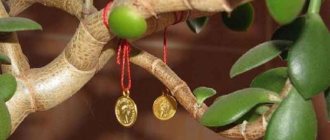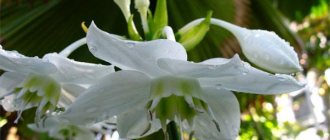Features of planting anthurium
In order for anthurium, or, as it is also called, “male happiness,” to please with its delightful flowering with bright red, orange or pink “cloaks,” be sure to plant it in a suitable soil mixture.
There are several options! This can be a special soil for aroid plants, which is lightweight and has excellent breathability due to the addition of coarse sand and crushed charcoal. Anthurium also grows well in soil for orchids, consisting of small pieces of tree bark; in this case, even drainage is not needed.
Photo: agrodom93.ru
Preparation
Before planting, you need not only to choose the right pot, but also to find acceptable and useful soil for anthurium.
Choosing a pot
Since the root system of anthurium is superficial, deep pots are not suitable for it. A moderately wide, but not completely “flattened” pot is an ideal option, since water will not stagnate in such a container. Experts recommend choosing pots made of plastic or glass. Moisture evaporates faster from ceramic or clay pots.
You can plant an anthurium in a clay pot, but to prevent the roots from growing in, the container must be covered inside with a layer of glaze.
Below is a table with the approximate suitable pot diameter for plants of different ages:
| Anthurium age | Pot diameter |
| 1-2 years | 11-14 cm |
| 3-4 years | 15-17 cm |
| 5-6 years | 18-20 cm |
Pots from 14 to 17 cm in height are suitable.
Important! If the abundant color of the plant is important, you need to plant the anthurium in a slightly cramped pot. For the appearance of children, a wider container is needed.
Priming
Be sure to lay out a drainage layer at the bottom of the pot (approximately 15% of the pot’s volume) to avoid stagnation of water and rotting of the roots.
Anthurium needs loose and well-drained slightly acidic (pH-5.5-6.5) soil with a sufficient amount of nutrients, into which air penetrates well. The flower will accept soil well for aroids. The following mixtures are also suitable:
- soil for azaleas;
- soil for begonias;
- soil for orchids.
Turf soil is not suitable for the plant - it can clog the roots and block access to air.
As a rule, high-moor peat serves as the basis for anthurium soil. If it is not possible to purchase it, any soil with a slightly acidic reaction will be suitable for flowering species.
Requirements for transplantation
Until “male happiness” reaches the age of five, replant it annually in a pot that is slightly larger in volume than the previous one. Then you can replant the plant once every 3 years, but be sure to remove damaged roots and plant new shoots. Don’t forget to add a layer of new coarse-grained drainage, pre-disinfected with boiling water, to the bottom of the pot (if you are using a soil mixture) to protect the root system from rotting.
Little trick:
If you want your anthurium to bloom profusely, then grow it in a pot that is a little too small for its roots. If you want to get “babies”, then transplant the plant into a spacious pot, very soon you will see that young shoots have begun to appear.
Photo: commons.wikimedia.org
Watering and spraying anthurium
All types of anthurium love water. In this regard, it is necessary to water it quite abundantly. As soon as you see that the top layer of soil has begun to dry out, water the plant thoroughly. Under no circumstances leave water in the saucer, otherwise the roots will begin to rot; drain the tray immediately after watering.
The soil mixture in the pot must not be allowed to dry out, otherwise the flower will stop growing, producing new leaves and flowers, and possibly wilting and developing diseases. But excessive watering is also deadly for anthurium, as is a long period of drought.
“Male Happiness” does not tolerate dry air well. Place a pot with a plant next to the aquarium or get a humidifier. You can also spray the air around the anthurium with a spray bottle. Try to prevent large droplets of water from falling on the leaves and flowers; after the moisture evaporates, whitish spots will remain on the surface of the bush, which is harmful to the plant itself, and its appearance will be spoiled. Pour warm boiled water into the spray bottle. The higher the air temperature in the apartment or house, the more often and diligently you spray the space around the flower.
Photo: botanichka.ru
Dracaena: home care, propagation and transplantation
Fertilizers and feeding of anthurium
Anthurium is an unpretentious plant and does not need frequent feeding. During the spring-summer period, it is enough to water the flower twice a month with settled water in which half the dose of fertilizers for aroids is dissolved. Also, “male happiness” responds well to foliar feeding; for this purpose, fertilizers are dissolved in water for spraying. The dosage required is minimal.
In general, if you replant the plant regularly and water it sufficiently and on time, you can do without fertilizing at all. Focus on the appearance of the flower; if it grows quickly and blooms profusely, then it does not need fertilizer at all.
Photo: landas.ru
What is better to plant in: which pot to choose?
Anthurium does not need a pot that is too large. When choosing containers, you need to focus on the volume of the root system. If it completely fills the container and there is still 1-1.5 cm of free space left, then this is quite enough for a young plant. Large planting containers are chosen when they want to get a lot of root shoots for flower propagation.
The material from which the pot is made is not particularly important. The main thing is that the container has drainage holes and is disinfected if it was previously used for other crops. To treat planting containers, you can use boiling water, laundry soap, or a solution of potassium permanganate.
Location and lighting
Florist experts say that although anthurium tolerates shade well, it should still be placed in a place well lit by sunlight. In a heavily shaded place, “male happiness” will stop growing and drop its flower stalks.
Direct rays are destructive for this plant; they will leave burns on the tender, juicy leaves. It is ideal if you find a place for your green pet not far from a window facing east or west. North and south windows are completely unsuitable.
If there is not enough natural light in your home, then take care of artificial lighting. For example, buy a special phytolamp; it is inexpensive and consumes little electricity.
In winter, place the anthurium away from the heating system and away from drafts. In summer, take the flowerpot out to the balcony; fresh air and temperature changes between day and night will be very useful for it.
Photo: mocah.org
Geranium: home care, propagation and transplantation
Room temperature
Anthurium, provided there is sufficient watering and moisture, will survive even the hottest summer. But it may not survive an excessive drop in air temperature. Try to ensure that the thermometer in the room where the flower is located does not fall below +16 degrees. If necessary, turn on the heater, but place it away from the plant. Reduce the frequency of watering to a minimum so that the sensitive root system does not freeze.
Ideal temperature conditions for indoor anthurium are from +18 to +25 degrees Celsius. In this case, “male happiness” will feel great, grow rapidly, and its flowering will be all year round.
Photo: rsute.ru
When is the best time to reproduce?
Transplantation of an adult plant and, therefore, propagation by shoots is best done in April - August. Spring and summer are the optimal time for vegetative propagation methods, since the plants are full of vitality, actively developing, the air temperature is quite high, and there is plenty of soft sunlight. During this time, the seedlings will be able to take root and grow stronger.
If a forced replanting of a plant is carried out in winter (plant disease after purchase), then, therefore, it is necessary to separate the shoots. But it will be much more difficult for them to take root; there is a high risk that the young plant will die.
How to rejuvenate anthurium?
The specificity of anthurium development is such that as new leaves grow, the old lower leaves die off. As a result, a gnarled trunk is formed, covered with dried dark remains of the stems.
Of course, the decorative appearance of the flower is completely lost. But don’t be upset; use a sharp knife to cut off the top of the anthurium, leaving a few internodes, and plant it in a separate pot with fresh, moistened soil for aroids. The flower will quickly take root and turn into a lush flowering bush. You can also root the top in water and then plant it in a pot with soil.
Photo: oir.mobi
How to grow an avocado from a seed at home
What kind of soil (soil, earth) is suitable?
Ready-made substrate for exotic crops can be purchased at a flower shop. If desired, you can easily prepare it yourself. To do this you need to have on hand:
- leaf humus;
- high peat;
- pine needles;
- washed river sand;
- moss;
- turf land;
- conifer bark.
All components are taken in equal proportions and mixed thoroughly. The result should be a loose, acidic soil mixture that is easily permeable to water and air.
Important! Before use, the soil must be disinfected in any available way: treated with Fitosporin, a solution of potassium permanganate, scalded with boiling water or calcined in the oven.
Anthurium propagation methods
Anthurium can be propagated in several ways. This may be the separation of a well-developed “baby” from the mother bush. Immediately plant the shoot with roots in a separate small flowerpot. With good care, it will grow quickly.
Another method does not require transplantation and also gives excellent results. If you look closely at the plant, you will see that it takes down aerial roots. Using a sharp knife, carefully cut off the leaf that has such a root at the base. Plant the cut part of the anthurium in a previously prepared pot with soil. Water and spray - everything is as usual!
As for the propagation of anthurium by seeds, it is quite possible, but still, at home, it is too complicated and rarely gives a positive result. In addition, seeds often grow into specimens that are more similar to wild forms of the plant, losing the decorative properties of the mother plant.
Photo: allplants.store
What to do if the plant does not take root?
If the flower has drooped leaves, then you can spray the plant with epin and place it under a plastic bag for a week. If the leaves begin to turn yellow, most likely the plant:
- hypothermic;
- receives little light;
- receives too much water, causing its root system to rot;
- excessive use of fertilizers (burns appear in the root system).
Depending on the cause of yellowing, it is necessary to either place the anthurium in a warm, bright place without drafts, water less and less frequently, or pour water around the edges of the pot, or remove fertilizing for a while (about a month).
Mineral fertilizers cause great harm to the root system of anthurium - they leave burns.
Anthurium is finicky, but it reproduces easily, quickly acclimatizes and takes root, the main thing is to properly care for the plant. Reproduction by vegetative means, more specifically by seeding, not only results in several healthy offspring, but also significantly rejuvenates the anthurium.











